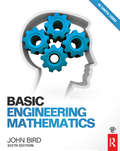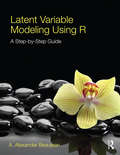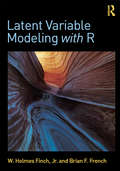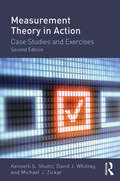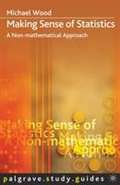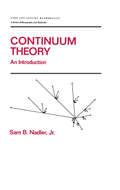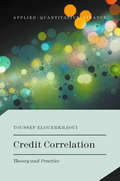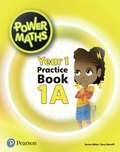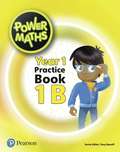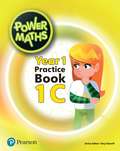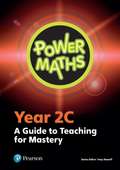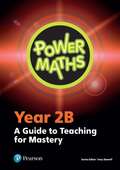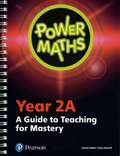- Table View
- List View
Basic Engineering Mathematics, 6th ed
by John BirdIntroductory mathematics written specifically for students new to engineering Now in its sixth edition, Basic Engineering Mathematics is an established textbook that has helped thousands of students to succeed in their exams. John Bird's approach is based on worked examples and interactive problems. This makes it ideal for students from a wide range of academic backgrounds as the student can work through the material at their own pace. Mathematical theories are explained in a straightforward manner, being supported by practical engineering examples and applications in order to ensure that readers can relate theory to practice. The extensive and thorough topic coverage makes this an ideal text for introductory level engineering courses. This title is supported by a companion website with resources for both students and lecturers, including lists of essential formulae, multiple choice tests, full solutions for all 1,600 further questions contained within the practice exercises, and biographical information on the 25 famous mathematicians and engineers referenced throughout the book. The companion website for this title can be accessed from www.routledge.com/cw/bird
Latent Variable Modeling Using R: A Step-by-Step Guide
by A. Alexander BeaujeanThis step-by-step guide is written for R and latent variable model (LVM) novices. Utilizing a path model approach and focusing on the lavaan package, this book is designed to help readers quickly understand LVMs and their analysis in R. The author reviews the reasoning behind the syntax selected and provides examples that demonstrate how to analyze data for a variety of LVMs.? Featuring examples applicable to psychology, education, business, and other social and health sciences, minimal text is devoted to theoretical underpinnings. The material is presented without?the use of matrix algebra. As a whole the book prepares readers to write about and interpret LVM results they obtain in R. Each chapter features background information, boldfaced key? terms defined in the glossary, detailed interpretations of R output, descriptions of how to write the analysis of results for publication, a summary, R based practice exercises (with solutions included in the back of the book), and references and related readings. Margin notes help readers better understand LVMs and write their own R syntax. Examples using data from published work across a variety of disciplines demonstrate how to use R syntax for analyzing and interpreting results. R functions, syntax, and the corresponding results appear in gray boxes to help readers quickly locate this material. A unique index helps readers quickly locate R?functions, packages, and datasets. The book and accompanying website at http://blogs.baylor.edu/rlatentvariable/ provides all of the data for the book’s examples and exercises as well as R syntax so readers can replicate the analyses. The book reviews how to enter the data into R, specify the LVMs, and obtain and interpret the estimated parameter values. The book opens with the fundamentals of using R including how to download the program, use functions, and enter and manipulate data. Chapters 2 and 3 introduce and then extend path models to include latent variables. Chapter 4 shows readers how to analyze a latent variable model with data from more than one group, while Chapter 5 shows how to analyze a latent variable model with data from more than one time period. Chapter 6 demonstrates the analysis of dichotomous variables, while Chapter 7 demonstrates how to analyze LVMs with missing data. Chapter 8 focuses on sample size determination using Monte Carlo methods, which can be used with a wide range of statistical models and account for missing data. The final chapter examines hierarchical LVMs, demonstrating both higher-order and bi-factor approaches. The book concludes with three Appendices: a review of common measures of model fit including their formulae and interpretation; syntax for other R latent variable models packages; and solutions for each chapter’s exercises. Intended as a supplementary text for graduate and/or advanced undergraduate courses on latent variable modeling, factor analysis, structural equation modeling, item response theory, measurement, or multivariate statistics taught in psychology, education, human development, business, economics, and social and health sciences, this book also appeals to researchers in these fields. Prerequisites include familiarity with basic statistical concepts, but knowledge of R is not assumed.
Latent Variable Modeling Using R: A Step-by-Step Guide
by A. Alexander BeaujeanThis step-by-step guide is written for R and latent variable model (LVM) novices. Utilizing a path model approach and focusing on the lavaan package, this book is designed to help readers quickly understand LVMs and their analysis in R. The author reviews the reasoning behind the syntax selected and provides examples that demonstrate how to analyze data for a variety of LVMs.? Featuring examples applicable to psychology, education, business, and other social and health sciences, minimal text is devoted to theoretical underpinnings. The material is presented without?the use of matrix algebra. As a whole the book prepares readers to write about and interpret LVM results they obtain in R. Each chapter features background information, boldfaced key? terms defined in the glossary, detailed interpretations of R output, descriptions of how to write the analysis of results for publication, a summary, R based practice exercises (with solutions included in the back of the book), and references and related readings. Margin notes help readers better understand LVMs and write their own R syntax. Examples using data from published work across a variety of disciplines demonstrate how to use R syntax for analyzing and interpreting results. R functions, syntax, and the corresponding results appear in gray boxes to help readers quickly locate this material. A unique index helps readers quickly locate R?functions, packages, and datasets. The book and accompanying website at http://blogs.baylor.edu/rlatentvariable/ provides all of the data for the book’s examples and exercises as well as R syntax so readers can replicate the analyses. The book reviews how to enter the data into R, specify the LVMs, and obtain and interpret the estimated parameter values. The book opens with the fundamentals of using R including how to download the program, use functions, and enter and manipulate data. Chapters 2 and 3 introduce and then extend path models to include latent variables. Chapter 4 shows readers how to analyze a latent variable model with data from more than one group, while Chapter 5 shows how to analyze a latent variable model with data from more than one time period. Chapter 6 demonstrates the analysis of dichotomous variables, while Chapter 7 demonstrates how to analyze LVMs with missing data. Chapter 8 focuses on sample size determination using Monte Carlo methods, which can be used with a wide range of statistical models and account for missing data. The final chapter examines hierarchical LVMs, demonstrating both higher-order and bi-factor approaches. The book concludes with three Appendices: a review of common measures of model fit including their formulae and interpretation; syntax for other R latent variable models packages; and solutions for each chapter’s exercises. Intended as a supplementary text for graduate and/or advanced undergraduate courses on latent variable modeling, factor analysis, structural equation modeling, item response theory, measurement, or multivariate statistics taught in psychology, education, human development, business, economics, and social and health sciences, this book also appeals to researchers in these fields. Prerequisites include familiarity with basic statistical concepts, but knowledge of R is not assumed.
Latent Variable Modeling with R
by W. Holmes Finch Brian F. FrenchThis book demonstrates how to conduct latent variable modeling (LVM) in R by highlighting the features of each model, their specialized uses, examples, sample code and output, and an interpretation of the results. Each chapter features a detailed example including the analysis of the data using R, the relevant theory, the assumptions underlying the model, and other statistical details to help readers better understand the models and interpret the results. Every R command necessary for conducting the analyses is described along with the resulting output which provides readers with a template to follow when they apply the methods to their own data. The basic information pertinent to each model, the newest developments in these areas, and the relevant R code to use them are reviewed. Each chapter also features an introduction, summary, and suggested readings. A glossary of the text’s boldfaced key terms and key R commands serve as helpful resources. The book is accompanied by a website with exercises, an answer key, and the in-text example data sets. Latent Variable Modeling with R: -Provides some examples that use messy data providing a more realistic situation readers will encounter with their own data. -Reviews a wide range of LVMs including factor analysis, structural equation modeling, item response theory, and mixture models and advanced topics such as fitting nonlinear structural equation models, nonparametric item response theory models, and mixture regression models. -Demonstrates how data simulation can help researchers better understand statistical methods and assist in selecting the necessary sample size prior to collecting data. -www.routledge.com/9780415832458 provides exercises that apply the models along with annotated R output answer keys and the data that corresponds to the in-text examples so readers can replicate the results and check their work. The book opens with basic instructions in how to use R to read data, download functions, and conduct basic analyses. From there, each chapter is dedicated to a different latent variable model including exploratory and confirmatory factor analysis (CFA), structural equation modeling (SEM), multiple groups CFA/SEM, least squares estimation, growth curve models, mixture models, item response theory (both dichotomous and polytomous items), differential item functioning (DIF), and correspondance analysis. ?The book concludes with a discussion of how data simulation can be used to better understand the workings of a statistical method and assist researchers in deciding on the necessary sample size prior to collecting data.? A mixture of independently developed R code along with available libraries for simulating latent models in R are provided so readers can use these simulations to analyze data using the methods introduced in the previous chapters. Intended for use in graduate or advanced undergraduate courses in latent variable modeling, factor analysis, structural equation modeling, item response theory, measurement, or multivariate statistics taught in psychology, education, human development, and social and health sciences, researchers in these fields also appreciate this book’s practical approach. The book provides sufficient conceptual background information to serve as a standalone text.? Familiarity with basic statistical concepts is assumed but basic knowledge of R is not.
Measurement Theory in Action: Case Studies and Exercises, Second Edition
by Kenneth S. Shultz David J. Whitney Michael J. ZickarThis book helps readers apply testing and measurement theories. Featuring 22 self-standing modules, instructors can pick and choose the ones that are most appropriate for their course. Each module features an overview of a measurement issue and a step-by-step application of that theory. Best practices provide recommendations for ensuring the appropriate application of the theory. Practical questions help students assess their understanding of the topic while the examples allow them to apply the material using real data. Two cases in each module depict typical dilemmas faced when applying measurement theory followed by Questions to Ponder to encourage critical examination of the issues noted in the cases. Each module contains exercises some of which require no computer access while others involve the use of SPSS to solve the problem. The book’s website houses the accompanying data sets and more. The book also features suggested readings, a glossary of the key terms, and a continuing exercise that incorporates many of the steps in the development of a measure of typical performance. Updated throughout to reflect recent changes in the field, the new edition also features: --A new co-author, Michael Zickar, who updated the advanced topics and added the new module on generalizability theory (Module 22). -Expanded coverage of reliability (Modules 5 & 6) and exploratory and confirmatory factor analysis (Modules 18 & 19) to help readers interpret results presented in journal articles. -Expanded Web Resources, Instructors will now find: suggested answers to the book’s questions and exercises; detailed worked solutions to the exercises; and PowerPoint slides. Students and instructors can access the SPSS data sets; additional exercises; the glossary; and website references that are helpful in understanding psychometric concepts. Part 1 provides an introduction to measurement theory and specs for scaling and testing and a review of statistics. Part 2 then progresses through practical issues related to text reliability, validation, meta-analysis and bias. Part 3 reviews practical issues related to text construction such as the development of measures of maximal performance, CTT item analysis, test scoring, developing measures of typical performance, and issues related to response styles and guessing. The book concludes with advanced topics such as multiple regression, exploratory and confirmatory factor analysis, item response theory (IRT), IRT applications including computer adaptive testing and differential item functioning, and generalizability theory. Ideal as a text for any psychometrics, testing and measurement, or multivariate statistics course taught in psychology, education, marketing and management, professional researchers in need of a quick refresher on applying measurement theory will also find this an invaluable reference.
Measurement Theory in Action: Case Studies and Exercises, Second Edition
by Kenneth S. Shultz David J. Whitney Michael J. ZickarThis book helps readers apply testing and measurement theories. Featuring 22 self-standing modules, instructors can pick and choose the ones that are most appropriate for their course. Each module features an overview of a measurement issue and a step-by-step application of that theory. Best practices provide recommendations for ensuring the appropriate application of the theory. Practical questions help students assess their understanding of the topic while the examples allow them to apply the material using real data. Two cases in each module depict typical dilemmas faced when applying measurement theory followed by Questions to Ponder to encourage critical examination of the issues noted in the cases. Each module contains exercises some of which require no computer access while others involve the use of SPSS to solve the problem. The book’s website houses the accompanying data sets and more. The book also features suggested readings, a glossary of the key terms, and a continuing exercise that incorporates many of the steps in the development of a measure of typical performance. Updated throughout to reflect recent changes in the field, the new edition also features: --A new co-author, Michael Zickar, who updated the advanced topics and added the new module on generalizability theory (Module 22). -Expanded coverage of reliability (Modules 5 & 6) and exploratory and confirmatory factor analysis (Modules 18 & 19) to help readers interpret results presented in journal articles. -Expanded Web Resources, Instructors will now find: suggested answers to the book’s questions and exercises; detailed worked solutions to the exercises; and PowerPoint slides. Students and instructors can access the SPSS data sets; additional exercises; the glossary; and website references that are helpful in understanding psychometric concepts. Part 1 provides an introduction to measurement theory and specs for scaling and testing and a review of statistics. Part 2 then progresses through practical issues related to text reliability, validation, meta-analysis and bias. Part 3 reviews practical issues related to text construction such as the development of measures of maximal performance, CTT item analysis, test scoring, developing measures of typical performance, and issues related to response styles and guessing. The book concludes with advanced topics such as multiple regression, exploratory and confirmatory factor analysis, item response theory (IRT), IRT applications including computer adaptive testing and differential item functioning, and generalizability theory. Ideal as a text for any psychometrics, testing and measurement, or multivariate statistics course taught in psychology, education, marketing and management, professional researchers in need of a quick refresher on applying measurement theory will also find this an invaluable reference.
Longitudinal Structural Equation Modeling: A Comprehensive Introduction (Multivariate Applications Series)
by Jason T. NewsomThis comprehensive resource reviews structural equation modeling (SEM) strategies for longitudinal data to help readers see which modeling options are available for which hypotheses. The author demonstrates how SEM is related to other longitudinal data techniques throughout. By exploring connections between models, readers gain a better understanding of when to choose one analysis over another. The book explores basic models to sophisticated ones including the statistical and conceptual underpinnings that are the building blocks of the analyses.? Accessibly written, research examples from the behavioral and social sciences and results interpretations are provided throughout. The emphasis is on concepts and practical guidance for applied research rather than on mathematical proofs. New terms are highlighted and defined in the glossary. Figures are included for every model along with detailed discussions of model specification and implementation issues.? Each chapter also includes examples of each model type, comment sections that provide practical guidance, model extensions, and recommended readings. Highlights include: Covers the major SEM approaches to longitudinal analysis in one resource. Explores connections between longitudinal SEM models to enhance integration.? Numerous examples that help readers match research questions to appropriate analyses and interpret results. Reviews practical issues related to model specification and estimation to reinforce connections.? Analyzes continuous and discrete (binary and ordinal) variables throughout for breadth not found in other sources. Reviews key SEM concepts for those who need a refresher (Ch. 1).? Emphasizes how to apply and interpret each model through realistic data examples. Provides the book’s data sets at www.longitudinalsem.com along with the Mplus and R-lavaan syntax used to generate the results. Introduces the LISREL notation system used throughout (Appendix A).? The chapters can be read out of order but it is best to read chapters 1 – 4 first because most of the later chapters refer back to them. The book opens with a review of latent variables and analysis of binary and ordinal variables. Chapter 2 applies this information to assessing longitudinal measurement invariance.? SEM tests of dependent means and proportions over time points are explored in Chapter 3, and stability and change, difference scores, and lagged regression are covered in Chapter 4. The remaining chapters are each devoted to one major type of longitudinal SEM -- repeated measures analysis models, full cross-lagged panel models and simplex models, modeling stability with state-trait models, linear and nonlinear growth curve models, latent difference score models, latent transition analysis, time series analysis, survival analysis, and attrition. Missing data is discussed in the context of many of the preceding models in Chapter 13.? Ideal for graduate courses on longitudinal (data) analysis, advanced SEM, longitudinal SEM, and/or advanced data (quantitative) analysis taught in the behavioral, social, and health sciences, this text also appeals to researchers in these fields. Intended for those without an extensive math background, prerequisites include familiarity with basic SEM. Matrix algebra is avoided in all but a few places.
Making Sense Of Statistics: A Non-mathematical Approach
by Michael WoodMaking Sense of Statistics provides a thorough, but accessible, introduction to statistics and probability, without the distractions of mathematics. The book does not require you to use any algebraic formulae or equations, but it does explain how and why methods work, and exactly what answers mean. Guidance is provided on how to design investigations, analyze data and interpret results. There are exercises and case studies from a variety of areas of application, and an accompanying website from which interactive spreadsheet models and data files can be downloaded.
Higher Engineering Mathematics
by John BirdNow in its eighth edition, Higher Engineering Mathematics has helped thousands of students succeed in their exams. Theory is kept to a minimum, with the emphasis firmly placed on problem-solving skills, making this a thoroughly practical introduction to the advanced engineering mathematics that students need to master. The extensive and thorough topic coverage makes this an ideal text for upper-level vocational courses and for undergraduate degree courses. It is also supported by a fully updated companion website with resources for both students and lecturers. It has full solutions to all 2,000 further questions contained in the 277 practice exercises.
Continuum Theory: An Introduction
by Sam NadlerA textbook for either a semester or year course for graduate students of mathematics who have had at least one course in topology. Introduces continuum theory through a combination of classical and modern techniques. Annotation copyright Book News, Inc. Portland, Or.
Continuum Theory: An Introduction
by Sam NadlerA textbook for either a semester or year course for graduate students of mathematics who have had at least one course in topology. Introduces continuum theory through a combination of classical and modern techniques. Annotation copyright Book News, Inc. Portland, Or.
Basic Statistical Methods and Models for the Sciences
by Judah RosenblattThe use of statistics in biology, medicine, engineering, and the sciences has grown dramatically in recent years and having a basic background in the subject has become a near necessity for students and researchers in these fields. Although many introductory statistics books already exist, too often their focus leans towards theory and few help readers gain effective experience in using a standard statistical software package.Designed to be used in a first course for graduate or upper-level undergraduate students, Basic Statistical Methods and Models builds a practical foundation in the use of statistical tools and imparts a clear understanding of their underlying assumptions and limitations. Without getting bogged down in proofs and derivations, thorough discussions help readers understand why the stated methods and results are reasonable. The use of the statistical software Minitab is integrated throughout the book, giving readers valuable experience with computer simulation and problem-solving techniques. The author focuses on applications and the models appropriate to each problem while emphasizing Monte Carlo methods, the Central Limit Theorem, confidence intervals, and power functions.The text assumes that readers have some degree of maturity in mathematics, but it does not require the use of calculus. This, along with its very clear explanations, generous number of exercises, and demonstrations of the extensive uses of statistics in diverse areas applications make Basic Statistical Methods and Models highly accessible to students in a wide range of disciplines.
Simulation of Dynamic Systems with MATLAB and Simulink, Third Edition
by Harold Klee Randal AllenThe book presents an integrated treatment of continuous simulation with all the background and essential prerequisites in one setting. This third edition features new material on Stochastic Information Packets (SIPs), Stochastic Library Units with Relationships Preserved (SLURPs), and Black Swans. It explains the process of converting a mathematical model of a continuous or discrete system to a simulation model and source code implementation, which can be explored to better understand the dynamic behavior of the system. For reinforced learning, the text features MATLAB and Simulink extensively, as well as many illustrative homework problems.
Credit Correlation: Theory and Practice (PDF)
by Youssef ElouerkhaouiThis book provides an advanced guide to correlation modelling for credit portfolios, providing both theoretical underpinnings and practical implementation guidance. The book picks up where pre-crisis credit books left off, offering guidance for quants on the latest tools and techniques for credit portfolio modelling in the presence of CVA (Credit Value Adjustments). Written at an advanced level, it assumes that readers are familiar with the fundamentals of credit modelling covered, for example, in the market leading books by Schonbucher (2003) and O’Kane (2008). Coverage will include the latest default correlation approaches; correlation modelling in the ‘Marshall-Olkin’ contagion framework, in the context of CVA; numerical implementation; and pricing, calibration and risk challenges.The explosive growth of credit derivatives markets in the early-to-mid 000’s was bought to a close by the 2007 financial crisis, where these instruments were held largely to blame for the economic downturn. However, in the wake of increased regulation across all financial instruments and the challenge of buying and selling bonds in large amounts, credit derivatives have once again been found to be the answer and the market has grown significantly. Written by a practitioner for practitioners, this book will also interest researchers in mathematical finance who want to understand how things happen and work ‘on the floor’. Building the reader’s knowledge from the ground up, and with numerous real life examples used throughout, this book will prove a popular reference for anyone with a mathematical mind interested credit markets.
Power Maths Year 1 Practice Book 1A (PDF)
by Pearson EducationUnderpinned by the most effective teaching practices, and created by a team of mastery experts led by Series Editor Tony Staneff, Power Maths is designed to make the whole-class mastery teaching approach work for you, your children and your school.
Power Maths Year 1 Practice Book 1B (PDF)
by Pearson EducationUnderpinned by the most effective teaching practices, and created by a team of mastery experts led by Series Editor Tony Staneff, Power Maths is designed to make the whole-class mastery teaching approach work for you, your children and your school.
Power Maths Year 1 Practice Book 1C (Power Maths Print)
by Pearson EducationUnderpinned by the most effective teaching practices, and created by a team of mastery experts led by Series Editor Tony Staneff, Power Maths is designed to make the whole-class mastery teaching approach work for you, your children and your school.
Power Maths Year 2C: A Guide to Teaching for Mastery (PDF) (Power Maths Print)
by Tony StaneffCreated by mastery experts and underpinned by the most effective teaching practices, Power Maths is designed to make the whole-class mastery teaching approach work for you, your children and your school.
Power Maths Year 2B: A Guide to Teaching for Mastery (PDF) (Power Maths Print)
by Tony StaneffCreated by mastery experts and underpinned by the most effective teaching practices, Power Maths is designed to make the whole-class mastery teaching approach work for you, your children and your school.
Power Maths Year 2A: A Guide to Teaching for Mastery (PDF)
by Tony StaneffCreated by mastery experts and underpinned by the most effective teaching practices, Power Maths is designed to make the whole-class mastery teaching approach work for you, your children and your school.
New GCSE Maths AQA Revision Guide: Higher - for the Grade 9-1 Course (with Online Edition) (PDF)
by Cgp BooksThis new edition of CGP’s Higher Level AQA GCSE Maths Revision Guide is bang-up-to-date for the latest ‘Grade 9-1’ course! It’s packed with concise, friendly explanations of every topic, backed up with plenty of step-by-step examples. Grade information (on the new 9-1 scale) is included to show the difficulty level of each topic, and there are exam-style questions at the bottom of each page to test you on the important skills. And finally, a unique code is printed in the book that gives you access to the free Online Edition of the whole book on your PC, Mac or tablet! For even more help with this course, don’t forget CGP’s matching Workbook (9781782943976), Exam Practice Workbook (9781782943945) and Grade 9 Exam Practice Workbook (9781782944164).
Spss For Psychologists (PDF)
by Nicola Brace Rosemary Snelgar Richard KempWith over 50,000 copies sold, this is the indispensable guide to SPSS. With its student-friendly layout, accessible style and unbeatable coverage, it provides you with a step-by-step tour and equips you with the knowledge you need to succeed in your degree. Written especially for psychology students, this book shows you how to get the most out of SPSS, and will be an essential resource no matter what your level of study is. Key features of the new edition: - Fully updated to cover SPSS version 20 and backward-compatible with other versions - New material on bivariate (simple) regression and expanded coverage of multiple regression - Two new SPSS data files for several complex statistical inferential tests - New 'how to report results' boxes guide students through their findings - Accessible layout and writing style, perfect for students In addition, a number of sample exercises, datasets and other useful resources can be found at www.palgrave.com/psychology/brace
Linear Systems Theory: Second Edition
by João P. HespanhaA fully updated textbook on linear systems theoryLinear systems theory is the cornerstone of control theory and a well-established discipline that focuses on linear differential equations from the perspective of control and estimation. This updated second edition of Linear Systems Theory covers the subject's key topics in a unique lecture-style format, making the book easy to use for instructors and students. João Hespanha looks at system representation, stability, controllability and state feedback, observability and state estimation, and realization theory. He provides the background for advanced modern control design techniques and feedback linearization and examines advanced foundational topics, such as multivariable poles and zeros and LQG/LQR. The textbook presents only the most essential mathematical derivations and places comments, discussion, and terminology in sidebars so that readers can follow the core material easily and without distraction. Annotated proofs with sidebars explain the techniques of proof construction, including contradiction, contraposition, cycles of implications to prove equivalence, and the difference between necessity and sufficiency. Annotated theoretical developments also use sidebars to discuss relevant commands available in MATLAB, allowing students to understand these tools. This second edition contains a large number of new practice exercises with solutions. Based on typical problems, these exercises guide students to succinct and precise answers, helping to clarify issues and consolidate knowledge. The book's balanced chapters can each be covered in approximately two hours of lecture time, simplifying course planning and student review. Easy-to-use textbook in unique lecture-style formatSidebars explain topics in further detailAnnotated proofs and discussions of MATLAB commandsBalanced chapters can each be taught in two hours of course lectureNew practice exercises with solutions included
Maths no problem workbook 1A (PDF)
by Foong Pui Yee Chang duo Hui Yeap Ban HarMaths — No Problem! is a series of textbooks and workbooks written to meet the requirements of the 2014 English National Curriculum. The focus of the series is on teaching to mastery. This research-based approach emphasises problem solving and utilises pupils' core competencies to develop a relational understanding of mathematical concepts. In 2017, Maths — No Problem! textbooks were the only resource to meet the Department of Education’s standard for excellence in maths mastery teaching. The good news? Your school might be eligible for match funding. Learn More Consultant and Author: Dr. Yeap Ban Har UK Consultant: Dr. Anne Hermanson Authors: Dr. Foong Pui Yee, Lim Li Gek Pearlyn, Wong Oon Hua
Maths - No Problem Textbook 1A (PDF)
by Foong Pui Yee Chang duo Hui Yeap Ban HarMaths — No Problem! is a series of textbooks and workbooks written to meet the requirements of the 2014 English National Curriculum. The focus of the series is on teaching to mastery. This research-based approach emphasises problem solving and utilises pupils' core competencies to develop a relational understanding of mathematical concepts. In 2017, Maths — No Problem! textbooks were the only resource to meet the Department of Education’s standard for excellence in maths mastery teaching. The good news? Your school might be eligible for match funding. Learn More Consultant and Author: Dr. Yeap Ban Har UK Consultant: Dr. Anne Hermanson Authors: Dr. Foong Pui Yee, Lim Li Gek Pearlyn, Wong Oon Hua
